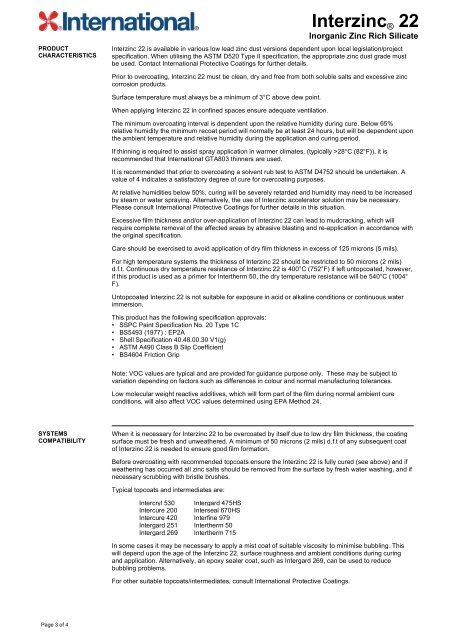English (United Kingdom) - Paul Wurth
English (United Kingdom) - Paul Wurth
English (United Kingdom) - Paul Wurth
- TAGS
- wurth
- www.paulwurth.com
You also want an ePaper? Increase the reach of your titles
YUMPU automatically turns print PDFs into web optimized ePapers that Google loves.
PRODUCT<br />
CHARACTERISTICS<br />
SYSTEMS<br />
COMPATIBILITY<br />
Page 3 of 4<br />
Interzinc ® 22<br />
Inorganic Zinc Rich Silicate<br />
Interzinc 22 is available in various low lead zinc dust versions dependent upon local legislation/project<br />
specification. When utilising the ASTM D520 Type II specification, the appropriate zinc dust grade must<br />
be used. Contact International Protective Coatings for further details.<br />
Prior to overcoating, Interzinc 22 must be clean, dry and free from both soluble salts and excessive zinc<br />
corrosion products.<br />
Surface temperature must always be a minimum of 3°C above dew point.<br />
When applying Interzinc 22 in confined spaces ensure adequate ventilation.<br />
The minimum overcoating interval is dependent upon the relative humidity during cure. Below 65%<br />
relative humidity the minimum recoat period will normally be at least 24 hours, but will be dependent upon<br />
the ambient temperature and relative humidity during the application and curing period.<br />
If thinning is required to assist spray application in warmer climates, (typically >28°C (82°F)), it is<br />
recommended that International GTA803 thinners are used.<br />
It is recommended that prior to overcoating a solvent rub test to ASTM D4752 should be undertaken. A<br />
value of 4 indicates a satisfactory degree of cure for overcoating purposes.<br />
At relative humidities below 50%, curing will be severely retarded and humidity may need to be increased<br />
by steam or water spraying. Alternatively, the use of Interzinc accelerator solution may be necessary.<br />
Please consult International Protective Coatings for further details in this situation.<br />
Excessive film thickness and/or over-application of Interzinc 22 can lead to mudcracking, which will<br />
require complete removal of the affected areas by abrasive blasting and re-application in accordance with<br />
the original specification.<br />
Care should be exercised to avoid application of dry film thickness in excess of 125 microns (5 mils).<br />
For high temperature systems the thickness of Interzinc 22 should be restricted to 50 microns (2 mils)<br />
d.f.t. Continuous dry temperature resistance of Interzinc 22 is 400°C (752°F) if left untopcoated, however,<br />
if this product is used as a primer for Intertherm 50, the dry temperature resistance will be 540°C (1004°<br />
F).<br />
Untopcoated Interzinc 22 is not suitable for exposure in acid or alkaline conditions or continuous water<br />
immersion.<br />
This product has the following specification approvals:<br />
SSPC Paint Specification No. 20 Type 1C<br />
BS5493 (1977) : EP2A<br />
Shell Specification 40.48.00.30 V1(g)<br />
ASTM A490 Class B Slip Coefficient<br />
BS4604 Friction Grip<br />
Note: VOC values are typical and are provided for guidance purpose only. These may be subject to<br />
variation depending on factors such as differences in colour and normal manufacturing tolerances.<br />
Low molecular weight reactive additives, which will form part of the film during normal ambient cure<br />
conditions, will also affect VOC values determined using EPA Method 24.<br />
When it is necessary for Interzinc 22 to be overcoated by itself due to low dry film thickness, the coating<br />
surface must be fresh and unweathered. A minimum of 50 microns (2 mils) d.f.t of any subsequent coat<br />
of Interzinc 22 is needed to ensure good film formation.<br />
Before overcoating with recommended topcoats ensure the Interzinc 22 is fully cured (see above) and if<br />
weathering has occurred all zinc salts should be removed from the surface by fresh water washing, and if<br />
necessary scrubbing with bristle brushes.<br />
Typical topcoats and intermediates are:<br />
Intercryl 530 Intergard 475HS<br />
Intercure 200 Interseal 670HS<br />
Intercure 420 Interfine 979<br />
Intergard 251 Intertherm 50<br />
Intergard 269 Intertherm 715<br />
In some cases it may be necessary to apply a mist coat of suitable viscosity to minimise bubbling. This<br />
will depend upon the age of the Interzinc 22, surface roughness and ambient conditions during curing<br />
and application. Alternatively, an epoxy sealer coat, such as Intergard 269, can be used to reduce<br />
bubbling problems.<br />
For other suitable topcoats/intermediates, consult International Protective Coatings.




